Building a better tomato: the quest to perfect the 'scandalous fruit'

Harry Klee, PhD, works in a one-story building on a rural part of the University of Florida campus. If this were science fiction, he’d wear a white coat and have an assistant named Ygor.
But Mary Shelley probably would find his calm, patient personality somewhat disappointing. The only monster that interests him is a better tomato.
Born in 1952, he is old enough to remember when tomatoes tasted like they were supposed to. “I sometimes wonder if there’s a whole generation of people who have never eaten a decent commercial tomato,” he says.
Sometimes, on an airplane, he’ll strike up a conversation with a gray-haired stranger about his favorite topic. If he explains he’s a molecular biologist he might receive a grunt in reply. If he talks about creating a tastier tomato his seatmate might start drooling. Those of us of a certain age, serious about our tomatoes, understand completely.
Klee grew up near Boston and enjoyed growing things, but at the University of Massachusetts he studied psychology. Interning at a psychiatric hospital, he wondered if mental illness had as much to do with chemistry as emotional trauma. So he changed focus. In graduate school, he got his doctorate in biochemistry, did postdoctoral work at the University of Washington, toiled in horticulture for Monsanto, and moved to Gainesville in 1995.
He served a stint as the director of the university’s plant molecular and cellular biology program, but he’ll answer to “Tomato Guy” or “Harry.” He’s considered a world expert on tomato chemistry.
For the record, he holds the Dickman Chair for Tomato Improvement. The late Paul Dickman founded Ruskin, Florida’s first tomato packing house in 1950; his son Glenn, a Realtor, still grows tomatoes at his “U-Pick” farm. Dickman told me recently he cares passionately about taste, which is why he helps fund Klee’s $2 million program. “The industry can do better,” he said.
So how did tomatoes, especially mass-market tomatoes, lose their mojo? Once upon a time—let’s say before 1960—tomatoes were a local seasonal crop wherever they were grown. In Harry Klee’s boyhood Massachusetts tomatoes were a summer treat, ripened the old-fashioned way, on the vine. Floridians ate them in late fall or early spring. After tomato season we ate watermelon or strawberries.
Tomatoes were temperamental fellows, prone to splitting and bruising, susceptible to cold and drought, heat and humidity, easy pickings for insects. But if eaten straight off the vine they tended to be out-of-this-world delicious.
Companies that supplied national markets, though, wanted what Klee calls an “industrial tomato,” one hardy enough to survive shipping, viruses, and insects. An industrial tomato would grow uniformly large and round. It would ripen, not a little at a time, but relatively quickly and evenly. An industrial tomato plant would produce big, profitable boxfuls of indestructible reddish cannonballs.
Scientists, cross-breeding different varieties, developed a kind of Frankenmato. The new boy was big, hard, and round. Picked green, it could be reddened by exposure to ethylene gas and not rot for weeks.
A Frankenmato could survive rough handling and bumpy shipping on roads and rails from Atlantic to Pacific. Thanks to the Frankenmato, Florida even became the winter tomato capital of North America.
Taste? Who cared about taste?
To read more of the story, go to http://www.upf.com/book.asp?id=KLINK004, where you can download the complete text, available from University Press, for $5.95.
The stories chronicled in GATORBYTES span all colleges and units across the UF campus. They detail the far-reaching impact of UF’s research, technologies, and innovations—and the UF faculty members dedicated to them. Gatorbytes describe how UF is continuing to build on its strengths and extend the reach of its efforts so that it can help even more people in even more places.
Gatorbytes are available from University Press of Florida [URL: www.upf.com] and can be found wherever books and ebooks are sold.